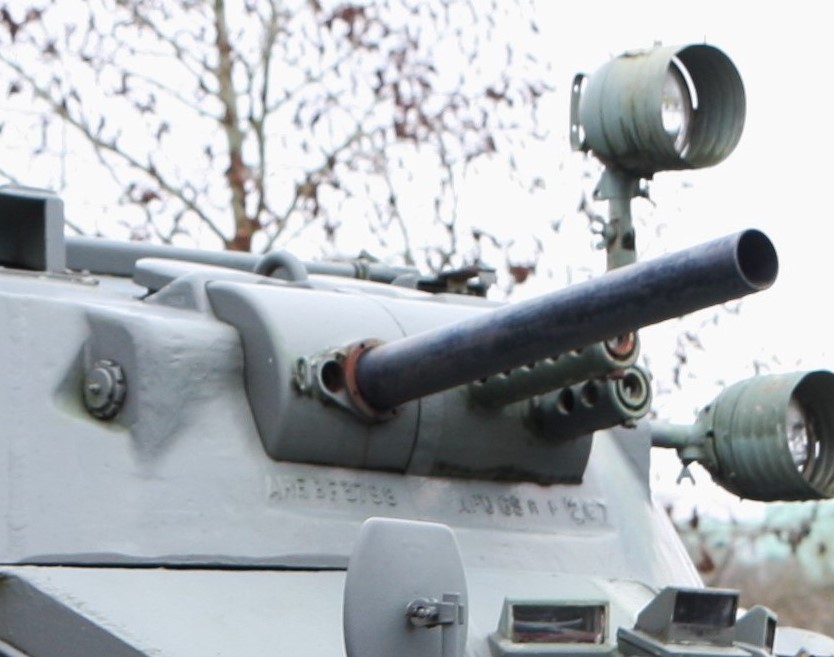Mortar carrier on:
[Wikipedia]
[Google]
[Amazon]




 A mortar carrier, or self-propelled mortar, is a
A mortar carrier, or self-propelled mortar, is a




 A mortar carrier, or self-propelled mortar, is a
A mortar carrier, or self-propelled mortar, is a self-propelled artillery
Self-propelled artillery (also called locomotive artillery) is artillery equipped with its own propulsion system to move toward its firing position. Within the terminology are the self-propelled gun, self-propelled howitzer, self-propelled ...
piece in which a mortar is the primary weapon. Simpler vehicles carry a standard infantry mortar while in more complex vehicles the mortar is fully integrated into the vehicle and cannot be dismounted from the vehicle. Mortar carriers cannot be fired while on the move and some must be dismounted to fire.
Evolution
The mortar carrier has its genesis in the general mechanisation and motorisation of infantry in the years leading up toWorld War II
World War II or the Second World War, often abbreviated as WWII or WW2, was a world war that lasted from 1939 to 1945. It involved the World War II by country, vast majority of the world's countries—including all of the great power ...
. To move an infantry mortar and its crew various methods were developed, for example mounting the mortar on a wheeled carriage for towing behind a light vehicle, attaching the mortar and its permanently fixed baseplate to the rear of a vehicle — the entire assembly hinging from the horizontal for travel and to the vertical to fire, simply transporting the disassembled mortar (tube, baseplate and bipod) its crew and mortar bombs by truck or half-track. Provision to allow the assembled mortar to be fired from inside the vehicle resulted in the most common form of the mortar carrier.
After World War II and the general introduction and acceptance of the armoured personnel carrier
An armoured personnel carrier (APC) is a broad type of armoured military vehicle designed to transport personnel and equipment in combat zones. Since World War I, APCs have become a very common piece of military equipment around the world.
Acc ...
(APC) variants of vehicles such as the FV432 and M113 were used as mortar carriers, carrying the mortar itself, its crew and a supply of ammunition. In such vehicles the mortar is positioned to fire out of the roof hatch of the vehicle, a turntable is fixed to the floor of the vehicle beneath the hatch to which the tube and standard bipod of the service infantry mortar can be mounted, the vehicle will also carry the mortar's baseplate (often outside the hull attached to the vehicle sides) to allow the mortar to be used dismounted.
In the battlefield taxi role mortar carriers have traditionally avoided direct contact with the enemy. Many units report never using secondary weapons in combat.
Some light armoured fighting vehicles, such the Panhard AML-60
The Panhard AML (''Auto Mitrailleuse Légère'', or "Light Machine Gun Car") is an armoured car with reconnaissance capability. Designed on a lightly armoured 4×4 chassis, it weighs an estimated 5.5 tonnes, and is thus suitable for airborne depl ...
and Ratel-60, use gun-mortars such as the Brandt Mle CM60A1 — which can be fired on a flat trajectory. This combination allowed a light vehicle to engage targets both directly and indirectly.
In addition to traditional infantry mortars, the Soviet Union introduced into service the 2B9 Vasilek, a gun-mortar capable of direct and indirect fire that was automatically fed. To fit in with their tactical doctrine and in order to allow the Vasilek to use its direct fire capabilities, the Soviet Union produced a mortar carrier in which the mortar was mounted, not inside the vehicle, but on top of it. The Soviet 2S9 Nona S9 may refer to:
Transportation
* SIAI S.9, a 1918 Italian flying boat
* Aircraft registration prefix of São Tomé and Príncipe
* USS ''S-9'' (SS-114), a 1920 S-class submarine of the United States Navy
* County Route S9 (California)
* Rans ...
and its successor the 2S31 Vena are true self-propelled mortars, being tracked turret mounted 120mm gun-mortars. Attached to light mobile units, such as the Russian Airborne Troops
The Russian Airborne Forces (russian: Воздушно-десантные войска России, ВДВ, Vozdushno-desantnye voyska Rossii, VDV) are the airborne forces branch of the Russian Armed Forces. It was formed in 1992 from units ...
the Nona and Vena, provides Russian commanders with additional mobile direct fire anti-armour and bunker-busting options.
Other self-propelled gun mortars are the Chinese PLL-05 and the Nordic AMOS/ NEMO automatic gun-mortars.
United States
In U.S. Army doctrine, mortar carriers are to provide close and immediate indirect fire support for manoeuvre units while allowing for rapid displacement and quick reaction to the tactical situation. The ability to relocate not only allows fire support to be provided where it is needed faster but also allows these units to avoid counter-battery fire. Prior to theIraq War
{{Infobox military conflict
, conflict = Iraq War {{Nobold, {{lang, ar, حرب العراق (Arabic) {{Nobold, {{lang, ku, شەڕی عێراق (Kurdish languages, Kurdish)
, partof = the Iraq conflict (2003–present), I ...
, American 120mm mortar platoons reorganised from six M1064 mortar carrier
The M1064 mortar carrier is an American vehicle, consisting of the M121 mortar – a version of the M120 mortar – mounted on an M113 chassis. The M1287 Mortar Carrier Vehicle will replace the M1064 in U.S. Army service.
Design
The design ...
s and two M577 Fire Direction Centers (FDCs) to four M1064 and one FDC.https://www.knox.army.mil/center/armormag/currentissues/2006/ja06/4ward06c.pdfMortar Platoon Training Focus to Meet the Evolving Battlefield The urban environment of Iraq made it difficult to use mortars. New technologies such as mortar ballistic computers and communication equipment are being integrated.
See also
* List of mortar carriersReferences
External links
{{Commonscat-inline, Mortar carriers Armoured fighting vehicles by type Self-propelled artillery